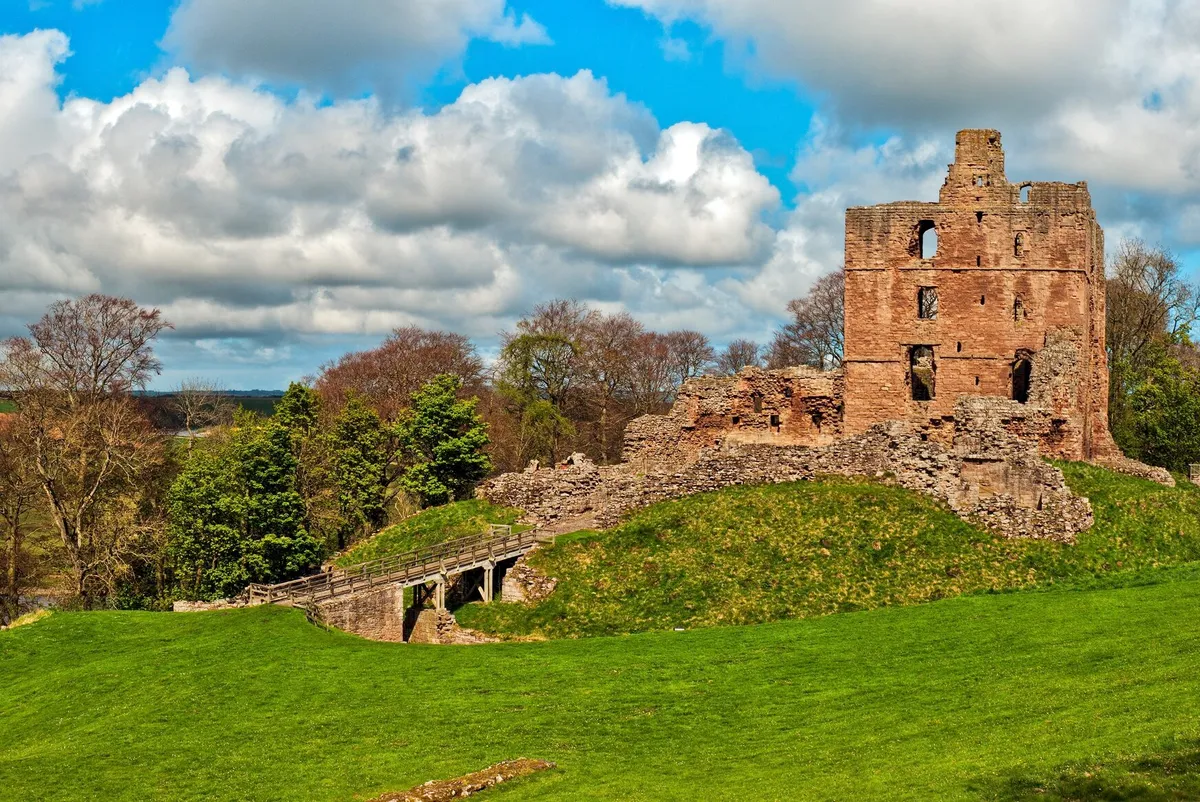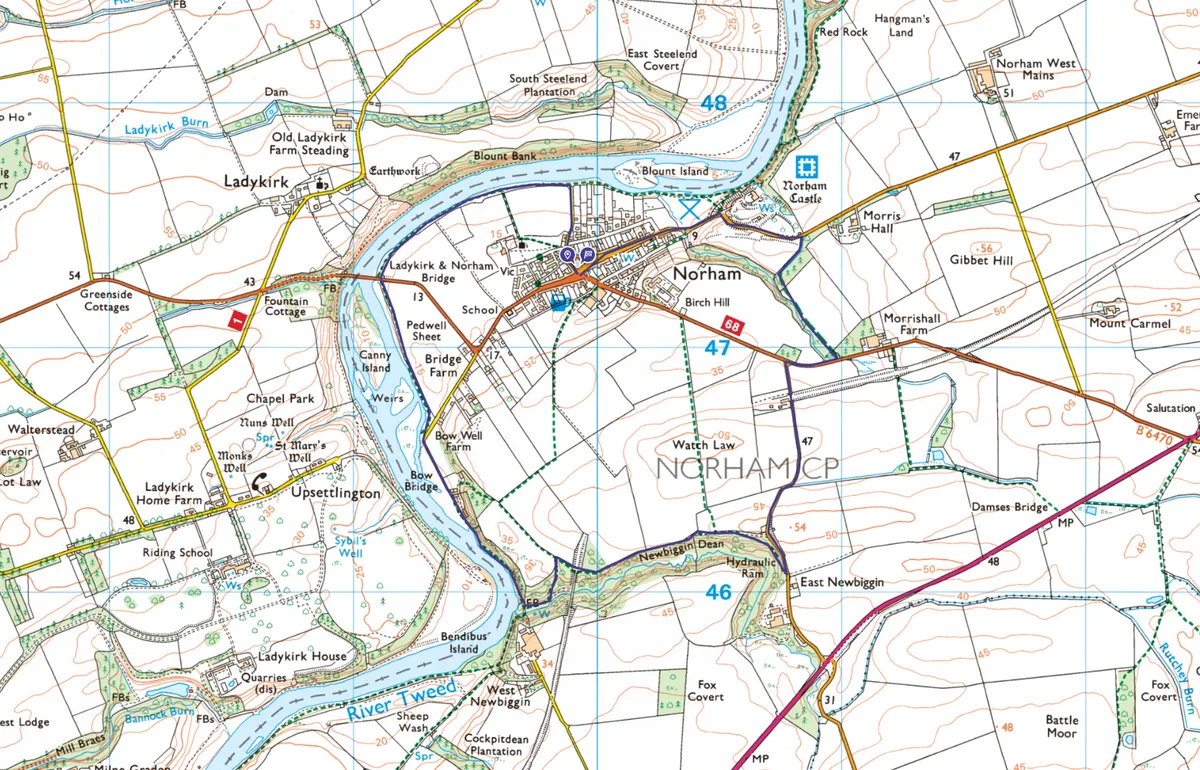Norham itself is an attractive and peaceful village, with the Mason Arms a perfect spot for a post-walk meal or refreshment.
Follow this marvellous 3.5-mile route through rural Northumberland along the River Tweed to end at Norham Castle.
Born in 1775 in London, Turner first visited Norham in 1797 and again in 1801 and 1831. The castle ruins, the River Tweed and the people working on the surrounding land obviously struck a chord with him, as he made many studies of them, of which Norham Castle, on the River Tweed is among the most celebrated.

Norham Castle walk
1. Down to the river
From Norham Village Green, walk down Pedwell Way to St Cuthbert’s Church. Go through the gates into the church grounds and follow a grassy track to the right of the church. This leads to a narrow path that descends to the River Tweed. Here you get a glimpse of Norham Castle – Turner would have painted and sketched along this stretch of the river.
2. Border bridge
Drop down the steps, turn left and follow a path west beside a gorgeous section of the river. The path approaches the arresting four-arched Ladykirk and Norham Bridge, which straddles the border between Scotland and England. It was built between 1885 and 1887.
Bear right onto a path, walk under the bridge, swing left and go over a stile. Turn right and follow a field edge path south towards some houses on the outskirts of Norham. Just before you reach them, turn right over a stile, then left and follow a woodland path on to a narrow road.
3. Twizell and Tweed
Turn right and follow the road to its end. Take a gate on the right signposted for ‘Twizell Bridge’ and the grassy path beside the Tweed. Beyond another gate, an undulating path continues along a stunning stretch of the river. Once through a third gate, go left at a junction (there is an old footbridge on the right) and through thicker woodland. At the next fork, keep left up steep steps then go through woodland to a junction. Go right and follow a path under an old railway arch into Newbiggin Wood. Continue over a stile, then bear right at a fork, signposted ‘East Newbiggin’. Follow the path through beautiful countryside to a gate.
4. To the castle
Once through, keep left on to a quiet road, wending through peaceful countryside to pass what used to be Norham Station (now converted into houses) until you reach the B6470. Go right, follow the road for 250 metres then turn left on to a path signposted ‘Public Bridleway to Norham Castle’.
5. Artist’s view
Cross a footbridge then go through a gate into a field. Keep to the field’s left edge, which will take you into some woodland, soon crossing a footbridge on the left. Once through a gate, turn right then follow another field edge through a gate to Castle Street. Turn left and walk the short distance into the castle grounds (entry is free). The view you’ll encounter is one that JMW Turner would have been very familiar with having sketched it from many angles.

The castle is a structure with a fascinating history. Between 1136 and 1513, raids by Scottish armies saw Norham Castle fall into Scottish hands on several occasions, garnering it a reputation for being the most dangerous place in England.
The castle’s long and rich history began in 1121 when it was founded by Ranulf Flambard, the Bishop of Durham. But its time as an important stronghold came to an end in 1559 when Queen Elizabeth I took control of it from the Bishop of Durham after he refused to swear an Oath of Supremacy to her.
Having explored the grounds, retrace your steps back to the road, turn right and then follow the pavement back to the village green.
Where to see the art
All of Turner’s paintings mentioned are on display at: Tate Britain, Millbank, London.
Explore more JMW Turner landscapes
Turner travelled far and wide in search of natural wonders to turn into artworks.
Buttermere, Lake District

JMW Turner travelled extensively across Britain and Europe including many trips to the Lake District and Yorkshire Dales. His depiction of Buttermere shows the lake in all its turbulent glory with a rainbow adding colour to the stormy canvas. A marvellous 4.5-mile walk circumnavigates the lake.
Gordale Scar, Yorkshire Dales

Turner’s painting of Gordale Scar, from a low vantage point, beautifully depicts the immense scale of the limestone chasm and cliffs, which rise to a height of around almost 100 metres. A stunning walk takes you up through Gordale Scar to reach Malham Tarn.
Coniston Fells, Cumbria

Morning Amongst the Coniston Fells reveals a striking landscape, far-reaching views and ever-changing weather within the Lake District mountains. There are a number of breathtaking routes through this part of the country but the Coniston Fells Circular is the outstanding classic.
Norham Castle map
Norham Castle walking route and map

